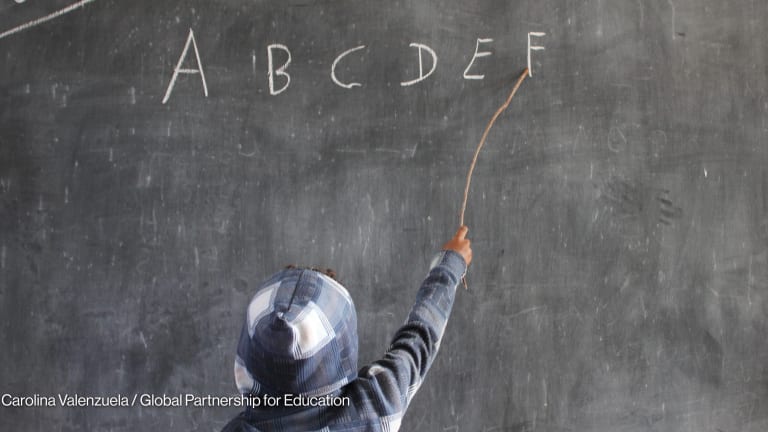
Globally, more than 350 million children are now being educated by nonstate providers, such as NGO schools, community schools, and low-fee private schools. In 2020, such schools accounted for 14% of primary school enrollments in sub-Saharan Africa and 38% of primary enrollments in Southern Asia.
The sector plays a key role in filling gaps in national education systems — for example, by providing schooling in informal settlements, crisis situations, and remote communities. As Sierra Leone’s education minister has pointed out, governments now financially support nonstate schools in 171 out of 204 countries, including “private schools in 115 countries, faith-based schools in 120 countries; and non-governmental organization and community schools in 81 countries.”
Recently, we’ve seen heated academic and policy debate about what role the nonstate sector should take. However, much of the discussion has been blind to the realities of the quality and access issues that have driven the growth of nonstate alternatives, as well as to the significant role that such provision now plays in education systems and to the constraints faced by governments.
For many governments, education from nonstate providers now accounts for a substantial proportion of their national education system capacity. With a global education financing gap of $75 billion per year, nonstate provision — often financed partially or wholly by household contributions — is not going away.
But we must also acknowledge that across both state and nonstate provision, education outcomes are too low and urgently need to be improved. The equity considerations raised as a result of the growth in nonstate education must be addressed as well.
We were pleased, therefore, to see UNESCO’s new “Global Education Monitoring Report” reject the simplistic and unhelpful “public versus private” framing that has characterized debate on this issue for so long.
The report instead recognizes that governments are charged with oversight of all education delivered within their borders, not just that delivered by the government sector. It sets out a vision for governments to work “in partnership with all actors” and to play a system stewardship role, with all institutions, students, and teachers seen as part of a single system.
The question that many education policymakers will now need to grapple with is how nonstate provision can be harnessed in a way that boosts education outcomes and quality in an equitable way. From our perspective, this means looking at the following three areas:
1. Investing in the capacity to regulate well. The headline takeaway from the GEM Report is that effective regulation can help to improve both quality and equity in education.
Regulation must be proportionate, transparent to parents, and focused on learning outcomes. Governments must avoid measures that focus excessively on inputs, that discourage educational innovation, or that seek to homogenize. Unfortunately, some current regulatory systems do the exact opposite: ignoring outcomes and focusing excessively on controlling inputs.
In India, for example, several laws prescribe aspects of school setup and operation in ways that are inappropriate, reducing providers’ ability to innovate under local context and constraints, as well as their ability to respond to the needs of parents and children. A new license for a private school in Delhi, for instance, requires 125 documents, which move through 155 steps at the education authority and through the hands of over 40 officers — a lengthy exercise open to corruption. Across the country, easily comparable data for all schools is not available publicly.
Many country governments need more financial and technical support to strengthen their regulatory systems. A review carried out by the Global Schools Forum in 2020 found a clear lack of guidance for governments that want a full view of their education systems, covering all providers. Meanwhile, recent research from the Center for Global Development found that compared with the advice they received on other issues, surveyed officials at education ministries were least satisfied with advice from donors about private schools.
Development partners and funders should now act to strengthen guidance on engagement with and regulation of nonstate provision provided through UNESCO and similar bodies. New investment is also needed in technical assistance programs to directly support governments in developing more regulatory capacity for both state and nonstate education.
2. Using the nonstate sector as a test bed for educational innovation. The education sector’s response to the COVID-19 pandemic over the past two years has demonstrated the importance of investing in innovation and testing new ways of delivering quality education. The nonstate sector can provide an effective space for new ideas to be trialed and tested, with the potential for the most successful and impactful innovations to be scaled up and expanded into the wider education system.
Increasingly, we are seeing more nonstate providers partner with governments and others to do just this. In Liberia and Sierra Leone, Rising Academy Network partnered with the government to develop a customizable and scalable set of radio lessons. In Pakistan, The Citizens Foundation has developed new versions of its teacher guides for partnership schools in Punjab. In Uganda, Promoting Equality in African Schools has worked with the government to pilot a school inspections and improvement program for government-run schools.
3. Ensuring equity. Finally, nonstate provision must be designed and financed in ways that enhance equity in education. This means, critically, ensuring that a quality, fee-free education option is available to all.
A quality publicly financed option enhances equity without sacrificing any gains that the nonstate sector can bring. In fact, evidence from Pakistan suggests that this may be an effective way to drive improvements in nonstate provision as well, with nonstate providers coming under pressure to boost quality in response to advancements by government schools.
This could also mean taking action to ensure that schooling currently financed through household spending on fees is accessible to the poorest children. This might include exploring policy options such as cash transfers for low-income households or public-private partnerships to remove costs for the poorest pupils attending nonstate schools.
Recent evidence from Uganda and Pakistan suggests that public-private partnerships may be an effective way to quickly increase learner enrollment. However, such programs also need to be well designed and require significant state capacity to succeed. Research into an Indian policy mandating that 25% of nonstate school capacity be provided free of charge to poorer households found that the majority of those would have paid for nonstate schools anyway.
Many education systems are in crisis, with long-standing challenges magnified by school closures amid the COVID-19 pandemic. As education ministries around the world continue their work to keep schools open and remediate learning loss, many nonstate education providers stand ready to play their part to support governments in giving all children the best possible start in life.









